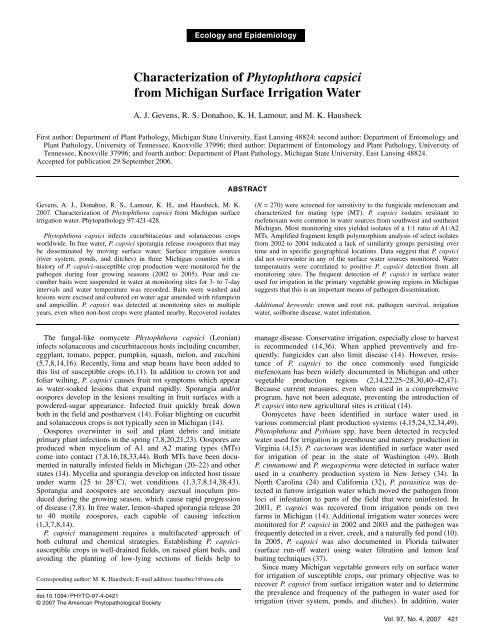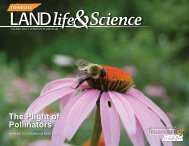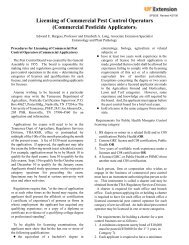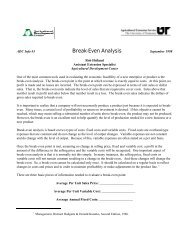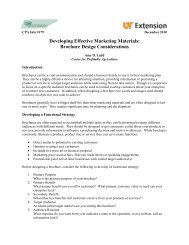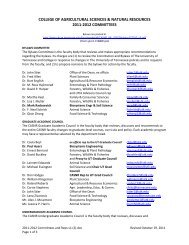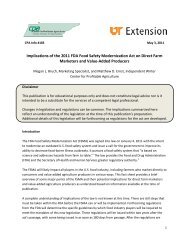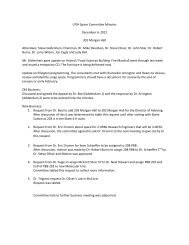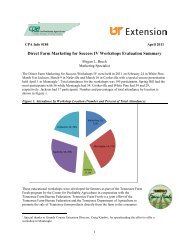Characterization of Phytophthora capsici from Michigan Surface ...
Characterization of Phytophthora capsici from Michigan Surface ...
Characterization of Phytophthora capsici from Michigan Surface ...
Create successful ePaper yourself
Turn your PDF publications into a flip-book with our unique Google optimized e-Paper software.
nearby field were sampled (foliage, stems, tubers, and associatedsoil), but the pathogen was not detected. At SW2 to SW6 sites,when a nearby field was planted to cucumber, P. <strong>capsici</strong> diseasesymptoms were observed and included fruit with water-soakedlesions and pathogen sporulation (Table 1).Ponds. P. <strong>capsici</strong> was detected in a naturally fed pond (NW1)and a pond fed by a deep well (NW3). In a second well-fed pond(NW2) with nearby field sites historically infested with P. <strong>capsici</strong>,the pathogen was not detected. Baiting in the naturally fed pond(NW1) was initiated late in the 2002 growing season in responseto crop loss in an adjacent field due to P. <strong>capsici</strong>. The pathogenwas detected immediately and throughout the remainder <strong>of</strong> thegrowing season. P. <strong>capsici</strong> was isolated <strong>from</strong> a nearby field <strong>of</strong>infected yellow squash in 2002 and <strong>from</strong> snap beans in 2003(Table 1). No P. <strong>capsici</strong> was recovered <strong>from</strong> sampled carrots in2004 (Table 1). Well-fed pond, NW3, had just a single baitingperiod with positive P. <strong>capsici</strong> detection.Ditches. In 2004, monitoring was initiated in response to widespreadand severe disease in a hand-harvested cucumber field inSE <strong>Michigan</strong> (Lenawee County). The detection <strong>of</strong> P. <strong>capsici</strong> atthis site (SE1: run-<strong>of</strong>f ditch) represents the first confirmation <strong>of</strong>this pathogen in water used for irrigation in SE <strong>Michigan</strong>. Despiteour interest in continuing to monitor this site in 2005, the growerdeclined. The 2005 NW <strong>Michigan</strong> ditch site (NW4: culvert ditch)represented a culvert that received run-<strong>of</strong>f <strong>from</strong> a number <strong>of</strong>fields, some with a known history <strong>of</strong> P. <strong>capsici</strong> infestation. Thepathogen was detected immediately following baiting initiationand throughout the remainder <strong>of</strong> the growing season (Table 1).MTs. For all monitoring sites where more than one P. <strong>capsici</strong>isolate was obtained, both A1 and A2 MTs were typically detected(Table 2). In several sites, the ratio <strong>of</strong> A1 to A2 was nearly 1:1when totaled over the monitored years. At sites where the ratiowas not close to a 1:1, the A1 MT occurred more frequently whenexamined across the isolate totals for a particular site (Table 2).Mefenoxam sensitivity. Each year, river sites yielded P. <strong>capsici</strong>isolates <strong>of</strong> each <strong>of</strong> the mefenoxam sensitivity categories (sensitive[S], intermediately sensitive [I], and resistant [R]) (Table 2).Approximately half <strong>of</strong> the P. <strong>capsici</strong> isolates <strong>from</strong> the river sitesin 2002 were I with one quarter <strong>of</strong> the isolates R (Table 2). Mostisolates <strong>from</strong> 2003 and 2004 were R (Table 2). In the last year <strong>of</strong>monitoring (2005), most (88%) isolates were S (Table 2).Nearly all P. <strong>capsici</strong> isolates collected <strong>from</strong> the NW <strong>Michigan</strong>region (Oceana County) during 2002 to 2005 were S (Table 2). In2002, there was a single I isolate collected (Table 2). The culvertditch monitored in 2005 yielded 14 P. <strong>capsici</strong> isolates, 13 <strong>of</strong> whichwere S to mefenoxam (Table 2). The majority <strong>of</strong> the P. <strong>capsici</strong>isolates <strong>from</strong> the run-<strong>of</strong>f ditch monitored in 2004 in SE <strong>Michigan</strong>(Lenawee County) collected were I and approximately 30% wereR (Table 2).Water temperature. Water temperatures were significantlycorrelated to positive P. <strong>capsici</strong> detection <strong>from</strong> the monitoringsites <strong>from</strong> 2002 to 2005 when analyzed using a nonlinear quadraticpolynomial regression (R 2 = 0.9408) (Fig. 4). Most (92%) <strong>of</strong>the baiting periods yielding P. <strong>capsici</strong> occurred during times whenwater temperatures were between 15 and 25°C (Table 3; Fig. 4).P. <strong>capsici</strong> was not identified <strong>from</strong> water sources when temperaturesfell below 14°C or rose above 25°C (Table 3). Average watertemperatures at the river monitoring sites during baiting periodswith positive P. <strong>capsici</strong> detection were 17 to 19°C. At the pondsites, average water temperatures during baiting periods withP. <strong>capsici</strong> infestation were 20 to 22°C. The run-<strong>of</strong>f and culvertditch sites had average water temperatures <strong>of</strong> 21°C during baitingperiods with positive P. <strong>capsici</strong> detection.Fig. 2. Amplified fragment length polymorphism similarity tree <strong>of</strong> <strong>Phytophthora</strong><strong>capsici</strong> isolated <strong>from</strong> <strong>Michigan</strong> surface water. Long-term numbers (LT#)refer to culture numbers maintained in the laboratory <strong>of</strong> M. K. Hausbeck at<strong>Michigan</strong> State University. Mating types (MT) are either A1 or A2.Mefenoxam sensitivity (MS) characteristics are sensitive (S), intermediatelysensitive (IS), and resistant (R).Fig. 3. Schematic <strong>of</strong> six sites along a river and creek system <strong>of</strong> southwest<strong>Michigan</strong> that were monitored for <strong>Phytophthora</strong> <strong>capsici</strong> infestation during thegrowing seasons <strong>of</strong> 2002 through 2005. Site 1 is a creek that flows into theriver. Arrows indicate direction <strong>of</strong> water flow.424 PHYTOPATHOLOGY
Rainfall. For the river system, total rainfall accumulation wasgreatest in 2003 and 2004 (Fig. 5). During baiting periods whenP. <strong>capsici</strong> was detected at river sites, rainfall accumulationaveraged
organisms were also isolated <strong>from</strong> both pear and cucumber fruitsduring the 4 years <strong>of</strong> monitoring. Based on morphologicalcharacteristics, Pythium spp. were identified, to genus only, eachyear and were prevalent during the early (April and May) and late(September and October) portions <strong>of</strong> the growing season (data notshown). P. citricola was identified to species by sequence analysis<strong>of</strong> the internal transcribed spacer 1 (ITS1) and ITS2 spacerregions (data not shown). Other <strong>Phytophthora</strong> spp. were identifiedto genus based on morphological characteristics.Water temperature exhibited some influence on the frequency<strong>of</strong> P. <strong>capsici</strong> detection. In our study, regression analysis determinedthat water temperatures were correlated with P. <strong>capsici</strong>incidence on pear and cucumber baits (R 2 = 0.9408). Thereappeared to be a lower temperature threshold (14°C) at whichP. <strong>capsici</strong> was not detected. When lupines were used to bait for<strong>Phytophthora</strong> spp. in cranberry irrigation reservoirs in NewJersey, a significant positive correlation was observed betweenwater temperature and detection <strong>of</strong> P. cinnamomi; a negative relationshipwas observed for temperature and P. megasperma (34).TABLE 3. Average water temperature (°C) during baiting periods <strong>from</strong> allsites and years (2002 to 2005) and the number <strong>of</strong> baiting periods with positivedetection <strong>of</strong> <strong>Phytophthora</strong> <strong>capsici</strong>Temperatureduring baiting (°C)Total no. <strong>of</strong>baiting periodsNo. <strong>of</strong> baiting periodswith P. <strong>capsici</strong>Incidence(%)5–10 24 0 010–15 114 6 815–20 277 47 1720–25 120 21 1825–30 8 0 0Fig. 5. Rainfall (weekly totals) and <strong>Phytophthora</strong> <strong>capsici</strong> detection data forSW river monitoring sites in Allegan County, <strong>Michigan</strong>, in A, 2002, B, 2003,C, 2004, and D, 2005. Gray vertical bars indicate rainfall (mm). Stars indicatepositive P. <strong>capsici</strong> detection.P. palmivora and P. citrophthora have been shown to remain motilein water at an optimal temperature <strong>of</strong> 17 and 12.5°C, respecttively(7). The length <strong>of</strong> time zoospores can continue to swim andremain viable may be impacted by water temperature (7,8).Further laboratory studies may elucidate the relationship betweenwater temperature and P. <strong>capsici</strong> zoospore activity. In <strong>Michigan</strong>,low water temperature typically occurs at a time when crops maynot be established (early spring) or have been removed (earlyfall).Frequency <strong>of</strong> P. <strong>capsici</strong> detection was greatest at river and ditchsites and rare at pond sites fed by deep wells. Although riverwater can have many potential points <strong>of</strong> infestation and is anunreliable source for clean irrigation water, ponds may alsoharbor P. <strong>capsici</strong>. The naturally fed pond, NW1, yielded P. <strong>capsici</strong>in each <strong>of</strong> the 4 years monitored despite the planting <strong>of</strong> non-hostcrops in the nearby field in two <strong>of</strong> these years. One <strong>of</strong> the twowell-fed ponds (NW3) yielded just one P. <strong>capsici</strong> isolate duringour monitoring. Ponds fed by deep wells are a safer option forgrowers than using surface water for irrigation, provided that run<strong>of</strong>f<strong>from</strong> nearby fields does not enter the holding pond. Theditches in our study received direct run-<strong>of</strong>f <strong>of</strong> water <strong>from</strong>numerous infested fields and yielded P. <strong>capsici</strong> for nearly everyperiod monitored. Both ditch sites fed into water retention/pumpingponds used for irrigation.Rain and/or irrigation events likely prompt run-<strong>of</strong>f <strong>from</strong> fieldswith P. <strong>capsici</strong>-infected crops into ditches, rivers, and creeks.However, precipitation data do not clearly indicate pathogendetection following significant rainfall. Grower irrigation datawere not collected and may have impacted surface water infestation.<strong>Michigan</strong> cucurbit growers attempt to provide an average <strong>of</strong>1 in. <strong>of</strong> water to their crops per week during the summer growingmonths. Monitoring water during the host crop-growing seasonindicated that irrigation water was <strong>of</strong>ten infested when the need toirrigate crops was highest, typically in late July and August,increasing the risk for pathogen dissemination.P. <strong>capsici</strong> was most frequently detected in water at monitoringsites during years when crown and fruit rot was observed in anearby field. However, P. <strong>capsici</strong> was consistently detected in irrigationsources even after 1 to 3 years without a host crop growingnearby. P. <strong>capsici</strong> can persist within the environment outside <strong>of</strong>host tissue (9,23,37). In <strong>Michigan</strong>, molecular techniques haveconfirmed that P. <strong>capsici</strong> oospores can survive dormantly in soilfor 3 years (23). Weed species have been identified as alternativehosts for P. <strong>capsici</strong> under Florida field conditions (9,35). P. <strong>capsici</strong>may be a weak pathogen <strong>of</strong> weed species or may simplycolonize weed root systems (9). In addition, rotational crops maynot be serving to limit the overall soil population <strong>of</strong> the pathogen.Snap beans were increasingly grown in rotation to vegetable cropsin <strong>Michigan</strong>, prior to 2003. Unfortunately, snap beans have sincebeen determined to be susceptible to P. <strong>capsici</strong> under fieldconditions in <strong>Michigan</strong> and other vegetable-producing regions <strong>of</strong>the United States (11).The consistent presence <strong>of</strong> the pathogen in moving surfacewater without a nearby infected host crop may indicate a longrange <strong>of</strong> movement <strong>of</strong> P. <strong>capsici</strong>. In a study <strong>of</strong> the movement <strong>of</strong> a<strong>Phytophthora</strong> sp. (interspecific hybrid <strong>of</strong> P. cambivora and anunknown <strong>Phytophthora</strong> sp. related to P. fragariae) on alder inBavaria, it was determined that once the pathogen was introducedinto a river system upstream, it infected alders downstream (17).In addition, area nurseries that had high incidence <strong>of</strong> infectedalder seedlings were found to be using water <strong>from</strong> infested rivercourses for irrigation (17). Due to the proximity <strong>of</strong> the <strong>Michigan</strong>river system to susceptible crop production, there are numerouspotential sources <strong>of</strong> P. <strong>capsici</strong> infestation. Drainage tiling mayalso be responsible for the movement <strong>of</strong> infested water. Subsurfacedrainage tiling, for removal <strong>of</strong> excess field water, occursthrough a network <strong>of</strong> perforated plastic tubes installed below thesoil surface. Water <strong>from</strong> the tiles eventually drains into ditches,426 PHYTOPATHOLOGY
etention ponds, rivers, creeks, and lakes. It is difficult to estimatehow far P. <strong>capsici</strong> can move via water based on the data presentedhere because we did not detect identical AFLP genotypes <strong>from</strong>multiple locations. The identical genotypes (similarity subgroups)recovered <strong>from</strong> individual sites likely represented the dispersal <strong>of</strong>asexual sporangia and zoospores, as P. <strong>capsici</strong> sporulates heavilyon host crops.Isolates <strong>of</strong> P. <strong>capsici</strong> resistant to mefenoxam may be disseminatedby irrigation. The extensive use <strong>of</strong> phenylamidefungicides for disease management can render P. <strong>capsici</strong> fieldpopulations resistant (19–21). Growers in SW <strong>Michigan</strong> have along history <strong>of</strong> phenylamide fungicide use (mefenoxam and/ormetalaxyl) compared with growers in NW <strong>Michigan</strong>. Mefenoxamhas been relied upon only in recent years to manage vegetablediseases in the SE region. <strong>Characterization</strong> <strong>of</strong> populations <strong>of</strong>P. <strong>capsici</strong> collected <strong>from</strong> SW <strong>Michigan</strong> <strong>from</strong> 1997 to 2001 indicateda high incidence <strong>of</strong> mefenoxam insensitivity (21), whereasisolates <strong>from</strong> NW <strong>Michigan</strong> were sensitive to the fungicide (20).In the first monitoring year (2002), most isolates obtained <strong>from</strong>the river sites in SW <strong>Michigan</strong> were intermediately sensitive tothe fungicide mefenoxam; in the subsequent 2 years, approximatelyhalf <strong>of</strong> the isolates were completely resistant. However, in2005, all but 10% <strong>of</strong> the isolates were sensitive to mefenoxam.From 2003 to 2005, SW <strong>Michigan</strong> vegetable growers eitheravoided or limited their use <strong>of</strong> mefenoxam because <strong>of</strong> its ineffectivenessin disease management due to fungicide resistance.Previously, a P. <strong>capsici</strong> field population <strong>from</strong> SW <strong>Michigan</strong> didnot revert <strong>from</strong> mefenoxam resistant to sensitive during a 2-yearrotation to non-host crops (21). The isolates collected in 2005<strong>from</strong> SW1 may have been introduced <strong>from</strong> a source different<strong>from</strong> the nearby field or the number <strong>of</strong> sensitive isolates may beelevated due to the influx <strong>of</strong> a single asexual genotype. It has beennoted with another oomycete pathogen (Pythium aphanidermatum)that metalaxyl-resistant isolates declined in number aftermetalaxyl use was eliminated for at least 3 years. Although thesensitive isolates became more prevalent, they were not in numberslarge enough to allow the use <strong>of</strong> metalaxyl for diseasemanagement (45).P. <strong>capsici</strong> does not appear to be overwintering (asexually) in thewater sources. Fingerprints were not monomorphic across years atindividual monitoring sites and the pathogen was never detectedin the spring or early summer. In addition, the pathogen was neverdetected prior to mid-July or after late September, despite watermonitoring efforts which began in April and ended in late Octoberfor most sites in this study. Continued irrigation baiting in 2006has yielded P. <strong>capsici</strong> <strong>from</strong> cucumber fruit as early as 30 June(M. K. Hausbeck, unpublished data). There was no associationbetween P. <strong>capsici</strong> similarity groups and specific locations oryears. This may be due to the relatively small sample sets analyzedor could be due to long-distance movement <strong>of</strong> the pathogen viathe water sources. The genotypic diversity among the isolatesanalyzed underscores the importance <strong>of</strong> sexual recombination inthe life cycle <strong>of</strong> P. <strong>capsici</strong> and also shows that these water sourcesprovide an important, genetically diverse, reservoir <strong>of</strong> propagulesduring key vegetable production months. Use <strong>of</strong> surface water forirrigation <strong>of</strong> P. <strong>capsici</strong>-susceptible crops should be avoided toprevent further spread <strong>of</strong> the pathogen.ACKNOWLEDGMENTSThis study was funded by <strong>Michigan</strong> Specialty Crop Block Grant forPickling Cucumbers: Increase Marketability <strong>of</strong> Cucumbers for Picklingby Decreasing Fruit Rot Caused by <strong>Phytophthora</strong> and Pythium andProject GREEEN (a cooperative effort by plant-based commodities andbusinesses with <strong>Michigan</strong> State University Extension, the <strong>Michigan</strong>Agricultural Experiment Station, and the <strong>Michigan</strong> Department <strong>of</strong> Agriculture).We thank J. Woodworth and K. Cervantes <strong>of</strong> <strong>Michigan</strong> StateUniversity for technical support, and the <strong>Michigan</strong> grower cooperatorswho allowed us access to surface water sources and nearby fields.LITERATURE CITED1. Alconero, R., and Santiago, A. 1972. Characteristics <strong>of</strong> asexualsporulation in <strong>Phytophthora</strong> palmivora and <strong>Phytophthora</strong> parasiticanicotianae. Phytopathology 62:993-997.2. Babadoost, M., and Islam, S. Z. 2001. Evaluation <strong>of</strong> fungicides forcontrol <strong>of</strong> <strong>Phytophthora</strong> blight <strong>of</strong> processing pumpkin, 2000. OnlinePublication. Fungic. Nematic. Tests 56:V65.3. Bernhardt, E. A., and Grogan, R. G. 1982. Effect <strong>of</strong> soil matric potentialon the formation and indirect germination <strong>of</strong> sporangia <strong>of</strong> <strong>Phytophthora</strong>parasitica, <strong>Phytophthora</strong> <strong>capsici</strong>, and <strong>Phytophthora</strong> cryptogea rots <strong>of</strong>tomatoes, Lycopersicon esculentum. Phytopathology 72:507-511.4. Bush, E. A., Hong, C., and Stromberg, E. L. 2003. Fluctuations <strong>of</strong><strong>Phytophthora</strong> and Pythium spp. in components <strong>of</strong> a recycling irrigationsystem. Plant Dis. 87:1500-1506.5. Crossan, D. F., Haasis, F. A., and Ellis, D. E. 1954. <strong>Phytophthora</strong> blight <strong>of</strong>summer squash. Plant Dis. Rep. 38:557-559.6. Davidson, C. R., Carroll, R. B., Evans, T. A., Mulrooney, R. P., and Kim,S. H. 2002. First report <strong>of</strong> <strong>Phytophthora</strong> <strong>capsici</strong> infecting lima bean(Phaseolus lunatus) in the Mid-Atlantic Region. Plant Dis. 86:1049.7. Erwin, D. C., Bartnicki-Garcia, S., and Tsao, P. H. 1983. Pages 60-276 in:<strong>Phytophthora</strong>: Its Biology, Taxonomy, Ecology, and Pathology. TheAmerican Phytopathological Society, St. Paul, MN.8. Erwin, D. C., and Ribeiro, O. K. 1996. Pages 50-266 in: <strong>Phytophthora</strong>Diseases Worldwide. The American Phytopathological Society, St. Paul,MN.9. French-Monar, R. D., Jones, J. B., and Roberts, P. D. 2006.<strong>Characterization</strong> <strong>of</strong> <strong>Phytophthora</strong> <strong>capsici</strong> associated with roots <strong>of</strong> weedson Florida vegetable farms. Plant Dis. 90:345-350.10. Gevens, A. J., and Hausbeck, M. K. 2004. <strong>Characterization</strong> anddistribution <strong>of</strong> <strong>Phytophthora</strong> <strong>capsici</strong> <strong>from</strong> irrigation water near <strong>Michigan</strong>cucurbit fields: A first report <strong>of</strong> <strong>Phytophthora</strong> <strong>capsici</strong> in irrigation water in<strong>Michigan</strong>. (Abstr.) Phytopathology 94(suppl.):S157.11. Gevens, A. J., and Hausbeck, M. K. 2004. <strong>Phytophthora</strong> <strong>capsici</strong> isolated<strong>from</strong> snap bean is pathogenic to cucumber fruit and soybean. (Abstr.)Phytopathology 95(suppl.):S162.12. Gevens, A. J., Lamour, K. H., and Hausbeck, M. K. 2005. Screeningcucumber germplasm for resistance to <strong>Phytophthora</strong> <strong>capsici</strong> using adetached fruit method. (Abstr.) Phytopathology 95(suppl.):S34.13. Habera, L., Smith, N., Donahoo, R., and Lamour, K. 2004. Use <strong>of</strong> a singleprimer to fluorescently label selective amplified fragment lengthpolymorphism reactions. BioTechniques 37:902-904.14. Hausbeck, M. K., and Lamour, K. H. 2004. <strong>Phytophthora</strong> <strong>capsici</strong> onvegetable crops: Research progress and management challenges. PlantDis. 88:1292-1303.15. Hong, C., Richardson, R. P., and Kong, P. 2002. Comparison <strong>of</strong>membrane filters as a tool for isolating Pythiaceous species <strong>from</strong>irrigation water. Phytopathology 92:610-616.16. Hwang, B. K., and Kim, C. H. 1995. <strong>Phytophthora</strong> blight <strong>of</strong> pepper andits control in Korea. Plant Dis. 79:221-227.17. Jung, T., and Blaschke, M. 2004. <strong>Phytophthora</strong> root and collar rot <strong>of</strong>alders in Bavaria: Distribution, modes <strong>of</strong> spread and possible managementstrategies. Plant Pathol. 53:197-208.18. Ko, W. 1988. Hormonal heterothallism and homothallism in <strong>Phytophthora</strong>.Annu. Rev. Phytopathol. 26:57-73.19. Lamour, K. H., and Hausbeck, M. K. 2000. Mefenoxam insensitivity andthe sexual stage <strong>of</strong> <strong>Phytophthora</strong> <strong>capsici</strong> in <strong>Michigan</strong> cucurbit fields.Phytopathology 90:396-400.20. Lamour, K. H., and Hausbeck, M. K. 2001. Investigating thespatiotemporal genetic structure <strong>of</strong> <strong>Phytophthora</strong> <strong>capsici</strong> in <strong>Michigan</strong>.Phytopathology 91:973-980.21. Lamour, K. H., and Hausbeck, M. K. 2001. The dynamics <strong>of</strong> mefenoxaminsensitivity in a recombining population <strong>of</strong> <strong>Phytophthora</strong> <strong>capsici</strong>characterized with amplified fragment length polymorphism markers.Phytopathology 91:553-557.22. Lamour, K. H., and Hausbeck, M. K. 2003. Susceptibility <strong>of</strong> mefenoxamtreatedcucurbits to isolates <strong>of</strong> <strong>Phytophthora</strong> <strong>capsici</strong> sensitive andinsensitive to mefenoxam. Plant Dis. 87:920-922.23. Lamour, K. H., and Hausbeck, M. K. 2003. Effect <strong>of</strong> crop rotation on thesurvival <strong>of</strong> <strong>Phytophthora</strong> <strong>capsici</strong> in <strong>Michigan</strong>. Plant Dis. 87:841-845.24. Larkin, R. P., Gumpertz, M. L., and Ristaino, J. B. 1995. Geostatisticalanalysis <strong>of</strong> <strong>Phytophthora</strong> epidemic development in commercial bellpepper fields. Phytopathology 85:191-203.25. Louws, F. J., Lancaster, M. E., Holmes, G. J., and Driver, J. G. 2000.Evaluation <strong>of</strong> fungicides and host resistance for control <strong>of</strong> <strong>Phytophthora</strong>crown rot <strong>of</strong> pepper, 1999. Fungic. Nematic. Tests 55:188.26. Matheron, M. E., and Porchas, M. 2002. Suppression <strong>of</strong> <strong>Phytophthora</strong>root and crown rot on pepper plants treated with acibenzolar-S-methyl.Plant Dis. 86:292-297.27. McGovern, R. J., Davis, T. A., Myers, D. S., and Seijo, T. E. 2003.Vol. 97, No. 4, 2007 427
Evaluation <strong>of</strong> fungicides for control <strong>of</strong> diseases <strong>of</strong> tropical pumpkin,2001. Online publication. Fungic. Nematic. Tests 58:V124.28. McGrath, M. T. 2004. Evaluation <strong>of</strong> fungicides for managing <strong>Phytophthora</strong>blight <strong>of</strong> squash, 2003. Online publication. Fungic. Nematic. Tests 59:V054.29. McIntosh, D. L. 1964. <strong>Phytophthora</strong> spp. in soils <strong>of</strong> the Okanagan andSimilkameen Valleys <strong>of</strong> British Columbia. Can. J. Bot. 42:1411-1415.30. Miller, S. A., Bhat, R. G., and Schmitthenner, A. F. 1994. Detection <strong>of</strong><strong>Phytophthora</strong> <strong>capsici</strong> in pepper and cucurbit crops in Ohio with twocommercial immunoassay kits. Plant Dis. 78:1042-1046.31. Mitchell, D. J., and Kannwischer-Mitchell, M. E. 1992. <strong>Phytophthora</strong>.Pages 31-38 in: Methods for Research on Soilborne PhytopathogenicFungi. L. L. Singleton, J. D. Mihail, and C. M. Rush, eds. The AmericanPhytopathological Society, St. Paul, MN.32. Neher, D., and Duniway, J. M. 1992. Dispersal <strong>of</strong> <strong>Phytophthora</strong>parasitica in tomato field by furrow irrigation. Plant Dis. 76:582-586.33. Noon, J. P., and Hickman, C. J. 1974. Oospore production by a singleisolate <strong>of</strong> <strong>Phytophthora</strong> <strong>capsici</strong> in the presence <strong>of</strong> chloroneb. Can. J. Bot.52:1591-1595.34. Oudemans, P. V. 1999. <strong>Phytophthora</strong> species associated with cranberryroot rot and surface irrigation water in New Jersey. Plant Dis. 83:251-258.35. Ploetz, R. C., Heine, G., Haynes, J., and Watson, M. 2002. Aninvestigation <strong>of</strong> biological attributes that may contribute to the importance<strong>of</strong> <strong>Phytophthora</strong> <strong>capsici</strong> as a vegetable pathogen in Florida. Ann. Appl.Biol. 140:61-67.36. Ristaino, J. B., and Johnston, S. A. 1999. Ecologically based approachesto management <strong>of</strong> <strong>Phytophthora</strong> blight on bell pepper. Plant Dis. 83:1080-1089.37. Roberts, P. D., French-Monar, R. D., H<strong>of</strong>fine, M. S., Seijo, T. E., andMcGovern, R. J. 2005. Survival and recovery <strong>of</strong> <strong>Phytophthora</strong> <strong>capsici</strong> andoomycetes in tailwater and soil <strong>from</strong> vegetable fields in Florida. Ann.Appl. Biol. 146:351-359.38. Schlub, R. L. 1983. Epidemiology <strong>of</strong> <strong>Phytophthora</strong> <strong>capsici</strong> on bellpepper. J. Agric. Sci. 100:7-11.39. Schmitthenner, A. F., and Bhat, R. G. 1994. Useful methods for studying<strong>Phytophthora</strong> in the laboratory. OARDC, Wooster, OH.40. Seebold, K. W., and Horten, T. B. 2003. Evaluation <strong>of</strong> fungicides forcontrol <strong>of</strong> <strong>Phytophthora</strong> crown and fruit rot <strong>of</strong> summer squash, 2002.Online publication. Fungic. Nematic. Tests 58:V098.41. Stevenson, W. R., James, R. V., and Rand, R. E. 2000. Evaluation <strong>of</strong>selected fungicides to control <strong>Phytophthora</strong> blight and fruit rot <strong>of</strong>cucumber. Fungic. Nematic. Tests 55:163.42. Stevenson, W. R., James, R. V., and Rand, R. E. 2001. Evaluation <strong>of</strong>selected fungicides to control <strong>Phytophthora</strong> blight and fruit rot <strong>of</strong>cucumber. Online publication. Fungic. Nematic. Tests 56:V16.43. Tucker, C. M. 1931. Taxonomy <strong>of</strong> the Genus <strong>Phytophthora</strong> DeBary.University <strong>of</strong> Missouri, Columbia.44. Uchida, J. Y., and Aragaki, M. 1980. Chemical stimulation <strong>of</strong> oosporeformation in <strong>Phytophthora</strong> <strong>capsici</strong>. Mycologia 72:1103-1108.45. Vargas, J. M., Jr. 2004. Fungicides. Pages 125-164 in: Management <strong>of</strong>Turfgrass Diseases, 3rd ed. Wiley Publishing, John Wiley & Sons,Hoboken, NJ.46. Vos, P., Hogers, R., Blecker, M., Reijans, M., van der Lee, T., Hornes, M.,Frijters, A., and Pot, J. 1995. AFLP: A new technique for DNAfingerprinting. Nucleic Acids Res. 23:4407-4414.47. Waldenmaier, C. M. 2004. Evaluation <strong>of</strong> fungicides for control <strong>of</strong>pumpkin diseases, 2003. Online publication. Fungic. Nematic. Tests59:V064.48. Waterhouse, G. 1963. Key to the species <strong>of</strong> <strong>Phytophthora</strong> de Bary.Mycological Papers, No. 92, Commonwealth Mycological Society, Kew,England.49. Yamak, F., Peever, T. L., Grove, G. G., and Boal, R. J. 2002. Occurrenceand identification <strong>of</strong> <strong>Phytophthora</strong> spp. pathogenic to pear fruit inirrigation water in the Wenatchee River valley <strong>of</strong> Washington State.Phytopathology 92:1210-1217.428 PHYTOPATHOLOGY


